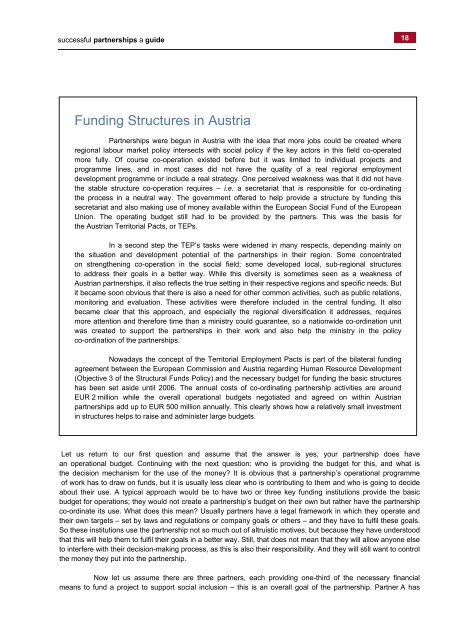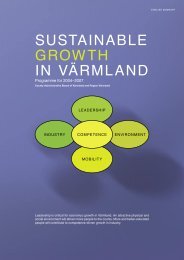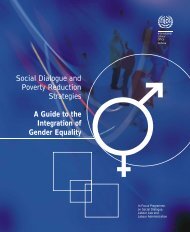successful partnerships a guide - Organisation for Economic Co ...
successful partnerships a guide - Organisation for Economic Co ...
successful partnerships a guide - Organisation for Economic Co ...
Create successful ePaper yourself
Turn your PDF publications into a flip-book with our unique Google optimized e-Paper software.
<strong>successful</strong> <strong>partnerships</strong> a <strong>guide</strong><br />
18<br />
Funding Structures in Austria<br />
Partnerships were begun in Austria with the idea that more jobs could be created where<br />
regional labour market policy intersects with social policy if the key actors in this field co-operated<br />
more fully. Of course co-operation existed be<strong>for</strong>e but it was limited to individual projects and<br />
programme lines, and in most cases did not have the quality of a real regional employment<br />
development programme or include a real strategy. One perceived weakness was that it did not have<br />
the stable structure co-operation requires – i.e. a secretariat that is responsible <strong>for</strong> co-ordinating<br />
the process in a neutral way. The government offered to help provide a structure by funding this<br />
secretariat and also making use of money available within the European Social Fund of the European<br />
Union. The operating budget still had to be provided by the partners. This was the basis <strong>for</strong><br />
the Austrian Territorial Pacts, or TEPs.<br />
In a second step the TEP’s tasks were widened in many respects, depending mainly on<br />
the situation and development potential of the <strong>partnerships</strong> in their region. Some concentrated<br />
on strengthening co-operation in the social field; some developed local, sub-regional structures<br />
to address their goals in a better way. While this diversity is sometimes seen as a weakness of<br />
Austrian <strong>partnerships</strong>, it also reflects the true setting in their respective regions and specific needs. But<br />
it became soon obvious that there is also a need <strong>for</strong> other common activities, such as public relations,<br />
monitoring and evaluation. These activities were there<strong>for</strong>e included in the central funding. It also<br />
became clear that this approach, and especially the regional diversification it addresses, requires<br />
more attention and there<strong>for</strong>e time than a ministry could guarantee, so a nationwide co-ordination unit<br />
was created to support the <strong>partnerships</strong> in their work and also help the ministry in the policy<br />
co-ordination of the <strong>partnerships</strong>.<br />
Nowadays the concept of the Territorial Employment Pacts is part of the bilateral funding<br />
agreement between the European <strong>Co</strong>mmission and Austria regarding Human Resource Development<br />
(Objective 3 of the Structural Funds Policy) and the necessary budget <strong>for</strong> funding the basic structures<br />
has been set aside until 2006. The annual costs of co-ordinating partnership activities are around<br />
EUR 2 million while the overall operational budgets negotiated and agreed on within Austrian<br />
<strong>partnerships</strong> add up to EUR 500 million annually. This clearly shows how a relatively small investment<br />
in structures helps to raise and administer large budgets.<br />
Let us return to our first question and assume that the answer is yes, your partnership does have<br />
an operational budget. <strong>Co</strong>ntinuing with the next question: who is providing the budget <strong>for</strong> this, and what is<br />
the decision mechanism <strong>for</strong> the use of the money It is obvious that a partnership’s operational programme<br />
of work has to draw on funds, but it is usually less clear who is contributing to them and who is going to decide<br />
about their use. A typical approach would be to have two or three key funding institutions provide the basic<br />
budget <strong>for</strong> operations; they would not create a partnership’s budget on their own but rather have the partnership<br />
co-ordinate its use. What does this mean Usually partners have a legal framework in which they operate and<br />
their own targets – set by laws and regulations or company goals or others – and they have to fulfil these goals.<br />
So these institutions use the partnership not so much out of altruistic motives, but because they have understood<br />
that this will help them to fulfil their goals in a better way. Still, that does not mean that they will allow anyone else<br />
to interfere with their decision-making process, as this is also their responsibility. And they will still want to control<br />
the money they put into the partnership.<br />
Now let us assume there are three partners, each providing one-third of the necessary financial<br />
means to fund a project to support social inclusion – this is an overall goal of the partnership. Partner A has








